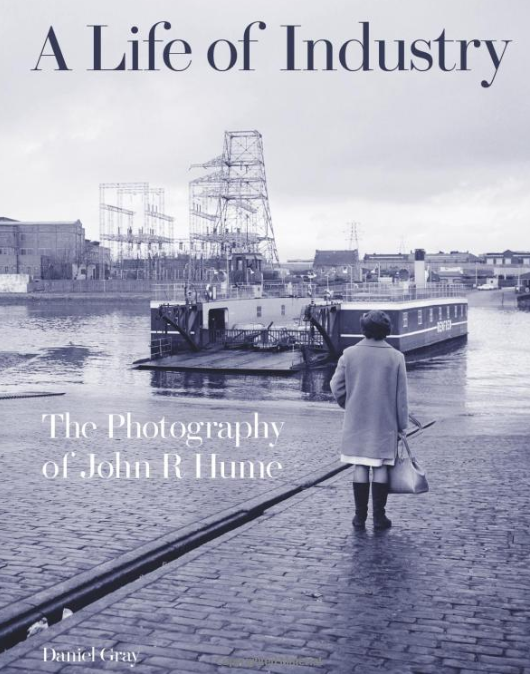A Life of Industry: the photography of John R Hume
A Life of Industry: the photography of John R Hume, by Daniel Gray, Historic Environment Scotland Enterprise, 2021, 176 pages, 250 illustrations, hardback.
‘There was a real purpose and character to the town, defined to a large extent by the character of industry, and the character of the industry also determined the character of the people.’
The industries of modern Scotland and something of their very essence are captured in this semi-biographical overview of John Hume’s incomparable photographic record. Hume is Scotland’s foremost expert on industrial heritage and the pun in the title is correct – the images are the product of dedicated application informed by a knowledgeable and perceptive eye, over more than half a century. What further distinguishes this book as more than a black-and-white record of Scotland’s industrial legacy, beyond the personal journey the photographs reveal, is the frequent inclusion of individuals going about their business, the vehicles accompanying the choice moments captured, the decades of his work. In collation through the themed chapters, the images provide a rich and vibrant insight of a nation’s industrial heritage, depicting its diversity, impact, evolution and decline.
How and perhaps more important why Hume became ‘Scotland’s leading industrial heritage expert’ is set out in the introduction, the chapter that explains ‘How Glasgow made John’. His visual curiosity, combined with his knowledge of science and technology, fuelled his creation of Strathclyde University’s first extramural industrial archaeology course from 1964. Before long he was a senior lecturer and ‘industrial archaeology’ was born as a credible academic subject. In the achievement of this significant step, Hume generously acknowledges his compatriots, notably Michael S Moss, with whom after joint explorations and archival research he co-authored two seminal texts.
Mostly dating to the 1960s and 1970s, the revealing photographs not only catalogue the decline of key industries but also show the powerful mark they made on their surrounding landscapes and communities. Be it the poster-like pages of industrial chimneys from across Scotland (their absence redefining the skylines) or the photographic medleys of eye-catching billboards and shopfronts (colourful adverts and accessible supply), these pages leave you in no doubt of the scale, contribution and human influence of this legacy.
The structure of the book is pleasing, balancing captioned images and informative text. Four illustrated chapters lead the reader thematically through Scotland’s industrial empire, from Bricks and Threads, the Giants and Urban Life. Each has both an introductory preface and an account of how Hume came to work with the subject matter, and the reactions to what he found. An artistic mother and family roots in both railway and maritime heritage, we learn, perhaps explain much of his early leanings and his lifelong passions.
The fifth chapter, ‘Coming Future’, builds on its predecessors and sets out just something of the wider contribution Hume’s knowledge has made. This goes far beyond the enormous value of his photographic record as so many of the sites met their demise, and concerns his considerable success in safe-keeping and preserving much of this heritage, set out here with a modesty characteristic of the man. As chief inspector scheduling and leading designations at Historic Scotland, thereafter as chairman of the Royal Commission on the Ancient and Historical Monuments of Scotland, and through outstanding advice given across the sector, Hume exercised his professional passion to great effect.
Future generations may still appreciate much of what shaped their world, and gave Scotland’s character a particular edge. The book’s only colour images here give some examples of the assets secured. And, fittingly, Gray’s preface to this chapter paints its reality in powerful words, providing a poignant ballad to the changing times.
This article originally appeared as ‘A ballad to changing times’ in the Institute of Historic Building Conservation’s (IHBC’s) Context 174, published in December 2022. It was written by Deborah Mays, head of listing at Historic England, who previously worked for 25 years at Historic Scotland, latterly as director.
--Institute of Historic Building Conservation
Related articles on Designing Buildings
- Conservation.
- Heritage.
- Historic environment.
- IHBC articles.
- Industrial Heritage Protection and Redevelopment.
- Industrial Heritage Re-tooled: the TICCIH guide to industrial heritage conservation.
- Institute of Historic Building Conservation.
- Listed buildings.
- Recording old industrial sites.
- The conservation challenge facing Ireland’s industrial heritage.
IHBC NewsBlog
Old Sarum fire in listed (& disputed) WW1 Hangar - Wiltshire Council has sought legal advice after fire engulfed a listed First World War hangar that was embroiled in a lengthy planning dispute.
UK Antarctic Heritage Trust launches ‘Virtual Visit’ website area
The Trust calls on people to 'Immerse yourself in our heritage – Making Antarctica Accessible'
Southend Council pledge to force Kursaal owners to maintain building
The Council has pledged to use ‘every tool in the toolbox’ if urgent repairs are not carried out.
HE’s Research Magazine publishes a major study of the heritage of England’s suburbs
The article traces the long evolution of an internal programme to research 200 years of suburban growth
IHBC Context 183 Wellbeing and Heritage published
The issue explores issues at the intersection of heritage and wellbeing.
SAVE celebrates 50 years of campaigning 1975-2025
SAVE Britain’s Heritage has announced events across the country to celebrate bringing new life to remarkable buildings.
IHBC Annual School 2025 - Shrewsbury 12-14 June
Themed Heritage in Context – Value: Plan: Change, join in-person or online.
200th Anniversary Celebration of the Modern Railway Planned
The Stockton & Darlington Railway opened on September 27, 1825.
Competence Framework Launched for Sustainability in the Built Environment
The Construction Industry Council (CIC) and the Edge have jointly published the framework.
Historic England Launches Wellbeing Strategy for Heritage
Whether through visiting, volunteering, learning or creative practice, engaging with heritage can strengthen confidence, resilience, hope and social connections.

















Comments
[edit] To make a comment about this article, click 'Add a comment' above. Separate your comments from any existing comments by inserting a horizontal line.